Do you know, as a personal trainer, you’ve lots of new, innovative ideas to market your personal training business? In this guide, we’ll teach you new age ideas to get new clients. A quick snapshot of what you’ll learn is listed below:
- Get new clients locally using Google My Business
- How to start a blog and launch an online personal training program
- Build your personal brand using Instagram, Youtube, and Facebook
- Start a Podcast and reach out to new audiences
- Brand yourself as an authority using Quora
- How to do content marketing, Email outreach, Influencer marketing, and more!
Are you ready to learn all the new age marketing ideas? Let’s get started!


#1 Google My Business
As a personal trainer, you’d be offering your services locally and to clients in nearby cities. Google My Business is a great platform to reach out to people in and near your location.
For example, you’re from NJ (New Jersey) and your business (or gym) is located at Moorestown. Lots of people in Moorestown and nearby townships would be searching in Google with keywords like:
- “personal trainer”
- “personal trainer near me”
- “fitness trainer”
How do you reach to people who search in Google? Let’s just take a look.


The screenshot (above) is business listings from Google My Business. When you search in Google “personal trainer” from NJ, a set of results will appear in Google as shown above.
If your business comes in the first 3 positions, you will get new inbound business leads like calls or messages.
I love digital marketing because it is supported by data. We can actually find out how many people search for “personal trainer” from the New Jersey area. Let’s see how.


If you look at the green marked rectangle and oval boxes, you can see that a number between 1000 to 10000 people search with keyword “personal trainer” or “personal trainer near me” every month.
If you look at the top portion of the screenshot, you can see “New Jersey, United States”. So all these searches (1K to 10K) happen from the New Jersey area alone.
So what does this data tell us?
You’ve got a wonderful opportunity to reach out to 1K to 10K people every month using Google My Business. I took this data with the help of Google Keyword planner tool. You can use this tool to find new keyword ideas and search volumes related to your business.
You may be from a different country & place, and you may be offering more specific, niche personal training services (for example TRX suspension training). But the concept of marketing your personal training in Google My Business remains the same.
You have to research the best keywords for you, create a Google My Business listing (using your business name and the keywords), and optimize the listing to rank high in Google search results.
#2 Start a Website and Blog
A well made website and a blog can do wonders for your business. You can reach to potential clients all across your country, or even the whole world using your website. A good website helps you to:
- Create a digital identity and personal brand
- Project your USP (unique selling proposition)
- Bring in visitors from the whole world
Do you know it is so easy to start a website and a blog? You can do it in just 3 steps. Before I show you how to start a website, let’s explore some real-life examples of personal trainers marketing really good with their websites.
Have you heard about the popular fitness blog NerdFitness? A classic example of using a blog to get new clients and take advantage of online business opportunities.
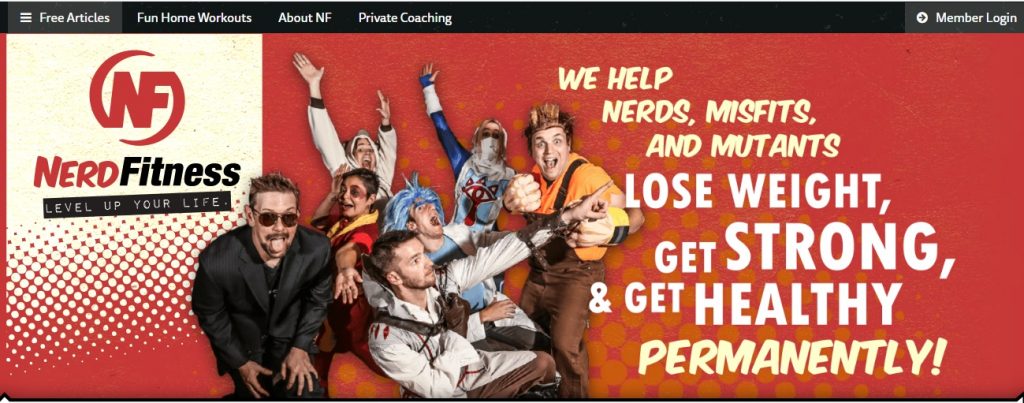

Steve Kamb started NerdFitness as a simple blog publishing 2 to 3 articles every week. He started in 2009 and over time he has built NerdFitness to a very popular blog with lots of useful articles and guides for fitness enthusiasts.
Steve started to generate revenue with one on one private coaching (acquiring leads from the blog), and he still uses private coaching as one of his main revenue sources.


NerdFitness now receives over 1.5 million visits per month and has multiple revenue sources. They generate revenues from an online membership program and private 1:1 coaching (online).
They take all their new clients from the blog traffic they receive (an example is shown in the image below). Apart from one on one coaching, selling “online courses” is a great option you can try on your website as an additional revenue source.
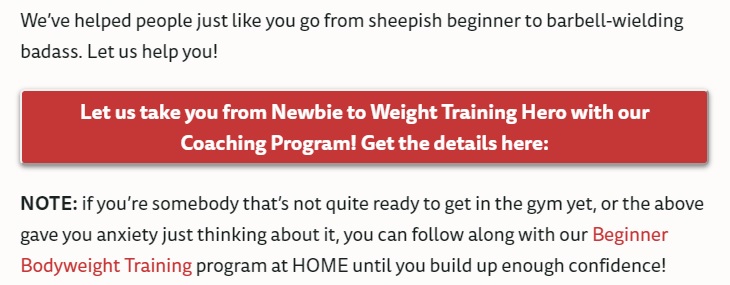

NerdFitness is just one of the many successful personal training blogs out there. You too can start a blog and build a successful personal training business.
You’ve multiple revenue options with a blog:
- Get new clients for one on one personal training
- Launch an online coaching program
- Make money from online advertisements & affiliate programs
- Sell your own online courses
- Launch your own branded products (online store)
What stops you from starting one?
How to Start a Website and a Blog
As I said before, starting a new website and a blog is pretty easy these days. In the olden days, everybody had to depend on a web designer/developer to launch a new website.
Fast forward 2020, we have lots of DIY website builders and tools which help to set up a website very easily. The best part is, anybody can set up a website/blog without any technical knowledge.
So let’s see how to start a website and a blog for your personal training business. I’ll teach you how to do this in 3 easy steps.
#1 Get your domain name
If you don’t know what is a domain name, don’t worry. Every website/blog needs a domain name.
For example, the domain name of this blog is GoMakeBig.com.
You’ve to find a domain name that is related to your niche – fitness & personal training. For example, NerdFitness by Steve Kamb, BornFitness by Adam Bornstein, PowerCakes by Kasey Brown are all interesting domain names. (You’ll see more examples down the lines)
You can search for the domain name availability on websites like Godaddy and register it for yourself.
Once you bought the domain name, you need to buy a hosting account.
Every website will have files to store like the website software (for example WordPress), images, text content, videos, etc. All these files need storage space on the internet, and a hosting company is what helps you store these files & software.
#2 Pick Your Blogging PLATFORM
I told you, there are multiple blogging platforms and website builders to start a website/blog.
The best option that I recommend is to use WordPress (content management system & blogging platform) and a normal shared hosting like Bluehost or a managed WordPress hosting solution like WPX Hosting.
If you’re new to WordPress, it is basically a free, opensource website powering software used by millions of people around the world.
You can get WordPress for free and can install it in your hosting environment within 10 minutes. Once WordPress is installed in your hosting (where your website/blog files and data are stored), you can set up your website so easily.
#3 Select The Best Hosting Account
You’ve two options when it comes to selecting the best hosting account for WordPress. You can either choose a fully managed WordPress hosting like WPX Hosting or you can choose a normal shared hosting for WordPress like Bluehost.
The difference here is, you’ll get complete and dedicated support for everything related to WordPress and web hosting in a fully managed hosting service like WPX Hosting. This means you’ll get a support staff to do things like WordPress installation, backup database, manage plugins, optimize bandwidth usage, scan for security issues, and so on.
In the case of a normal shared hosting like Bluehost, you’ve to manage the WordPress yourself. You’ve to do everything related to WordPress like installation, backups, plugins & themes, security all by yourself.
You’ll get support related to hosting your domain like they will take weekly backups, they will do a security scan (but they won’t help you fix the issue, you’ve to do it yourself) and all those stuff related to web hosting.
The key advantage of a normal shared WordPress hosting is its budget-friendliness compared to a managed service. You’ll get a normal shared hosting at 1/4th the cost of a managed hosting service.
So what you need to do to build a website is very simple. Buy a domain name, Buy a hosting account, and install WordPress.
After installing WordPress, get a template (suitable for personal trainers) from a website like Themeforest. If you want to look out for free templates, try in WordPress Themes Directory and in Google.
Choose a template that appeals to you and install it in your WordPress. You’re done! Your brand new personal training website is ready & live. Now all you need to do is add contents – text, images, and videos.
#3 On INSTAGRAM & Facebook – BUILD YOUR PERSONAL BRAND


Instagram is all about building your personal clout & influence. You build followers by publishing photos & videos of your lifestyle (obviously they have to be related to fitness & training).
Is posting photos & videos enough? No! You’ve to strategically promote each & every post (photos & videos) to your target audience. Instagram has paid promotions and you gotta use them with a clear plan.
I know you’re waiting for real examples! Let’s begin with Mike Chabot – who has more than 1 million followers on Instagram.
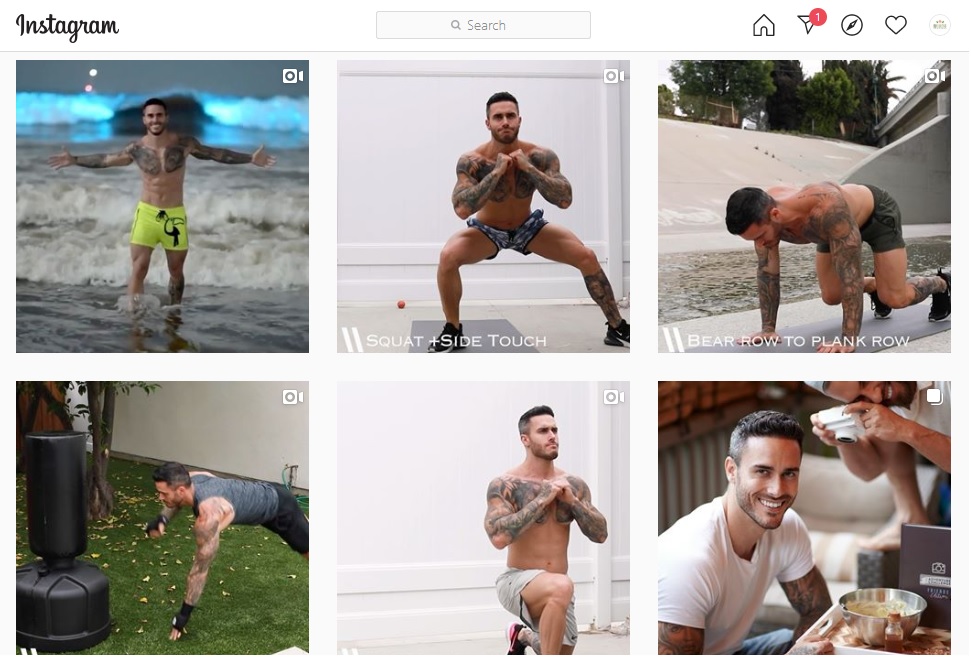

Mike is a personal trainer and he offers VIP coaching programs. He’s successful in Instagram & TikTok (with more than 1 million followers) and markets his coaching services to followers on Instagram and TikTok.


You need to setup the basic things first. In Facebook, you need to setup a page for your personal trainer business. You’ve to complete all the basic info, add logos, cover images and all those basic stuff. In Instagram, you’ve to setup your profile (create a business profile) first, completing basic info and profile image. Once the basic setup is complete, you’ve to build your audience in both Facebook & Instagram.
Building an audience is a time taking process. The best strategy to build an audience is to add content like images, videos, articles, and so on. On Facebook, the audience will like your page and follow to get new updates. On Instagram, the audience follows your profile. As a personal trainer, you can share content related to your business.
You’ve to build and share content that is really useful to your audience. They will love the content if there is a ‘WOW’ factor. For example:
- you can share images that explain the best diet, recipe pics,
- you can share photos of work out postures, routines, weight training
- you can share videos explaining work out tips, and more.
Your audience will grow naturally with time.
So how to grow your followers & page likes quickly?
The best method to grow the audience quickly is by using paid promotions on Facebook & Instagram. You can promote your content to the target audience and increase the reach of your page & profile. This way you will get more eyeballs quickly, and your audience will grow faster.
#4 Market on Youtube
Youtube is another great medium to promote your personal training business.
What you have to do with Youtube is pretty simple & straightforward.
You’ve to start a Youtube channel in the name of your personal training business (or your own name), create and upload new videos. The videos should be related to fitness, educating, and motivating your potential clients.
Over time, the audience will grow on Youtube in the form of views & subscribers. Youtube is a great platform used by billions of people every month to watch videos. Your videos will be viewed by thousands of people every day, reaching your brand to more eyeballs.
You know, I won’t let you down without examples!
The AxFit Youtube channel by Danielle Chevalier is a good example, to begin with. Danielle started as a personal trainer taking clients locally from her city in 2006. She launched the website AxFit.com (including a blog) in 2006 while she started personal training, and in 2010 she launched the Youtube channel.


Over the years Danielle has grown her business many folds, and now she focus mainly on group training work outs.
She has online coaching programs for personal trainers on group training workouts, methods and so on. The AxFit Youtube channel has 60K+ subscribers and the videos have more than 11 million views.
You see the power of a Youtube channel! Danielle has taken her brand to the eyes of 11 million people using Youtube.
The website and blog AxFit.com is also popular and she runs all the online coaching programs through her website. Danielle uses Instagram really well for marketing, and she’s also active on Facebook (though not aggressive as in Insta).
Heather Robertson
Heather brands her personal training business in her name. She uses Youtube and Instagram as the main marketing channels. The viewers on Youtube are presented with a 12-week online training program on her website. She also blogs actively to market her fitness training services.
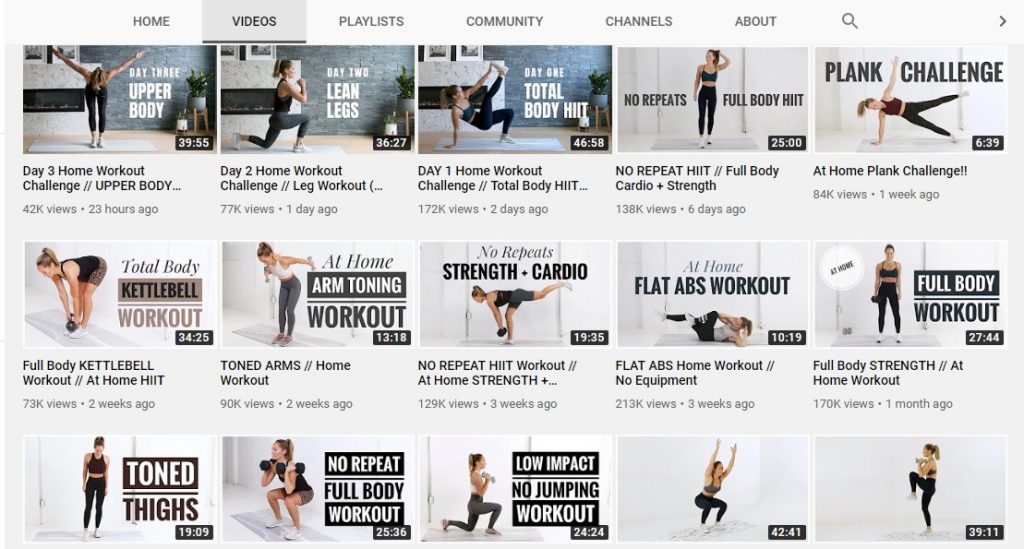

Heather is active on Facebook as well. She makes use of videos on Facebook for marketing her brand. The key takeaway from Heather is that she is focused on building her personal brand. She’s a model, personal trainer, and fitness influencer. You see how digital channels like Instagram, Youtube, and a blog can make you a celebrity!
VahvaFitness by Samuli & Eero
VahvaFitness is another great example for personal trainers who are just starting out. Founded by two personal trainers from Finland, Samuli T. Jyrkinen and Eero Westerberg, they offer personal coaching (online and offline) and also packaged online programs.


Vahva Fitness also markets using Facebook and Instagram. On Youtube, they have 420K+ subscribers and their videos have got more than 38 million views so far. Their website/blog is also popular and they receive more than 110K visitors every month.
#6 Be on Quora – Build Your Authority
You may know Quora as a Q&A platform. But do you know, you can build a powerful personal brand using Quora?
People ask various questions in Quora and you help them by sharing your knowledge as answers. As you answer more questions, people will start following you on Quora, your profile will get many views and you will be recognized as an authority & expert in your fitness niche.
Geoffrey Schofield on Quora
Geoffrey is a great example for any new personal trainer to follow. He markets actively on Quora by answering questions related to fitness. If you take a look at the screenshot below, you can see Geoffrey has 16K+ followers, 1400+ answers, and over 4 million views per month (for all his answers).


This simply means, around 4 million people read his answers on Quora, and those who get an interest in those answers look for his bio & Quora profile. The profile clearly states Geoffrey is a personal trainer, and you can see links to his website (where he sells coaching) and other social profiles (like Facebook, Instagram, and more). Quora also has a direct messaging feature, so those who have an interest in hiring may send you personal messages as well.
Quick Strategies to Win Quora Marketing
Winning on Quora needs patience. You won’t get followers and views from day 1 or 2. You’ve to keep writing answers and helping people frequently for 3 to 4 months. I’ve pinned down some quick points to keep in your mind.
- Write 4 to 5 answers every day, frequently. Make this part of your life.
- Your answers should be genuine, and helpful to the readers.
- Try to stand out with unique answers
- Your profile should be complete, explain what you do, link to your website and social media.
What kind of questions gets maximum views on Quora?
Try to find questions that have lots of followers, say 500+ followers. Answer such questions with a higher number of followers, as shown in the image below.
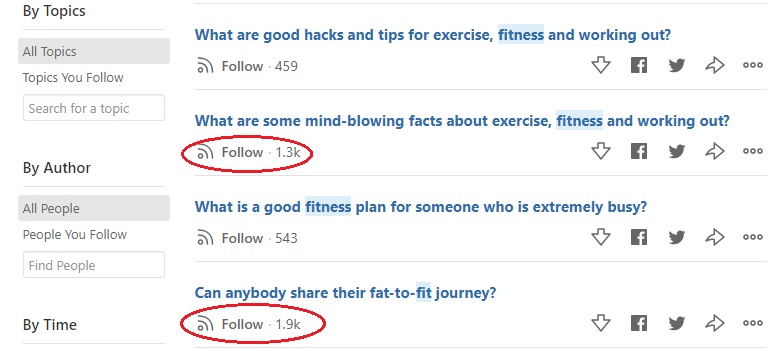

Look for Quora pages that already rank in Google.
For example, the screenshot below shows a Quora page that ranks for query “how do I build biceps”. The answers you write on such pages will get traffic from Google and hence more views.
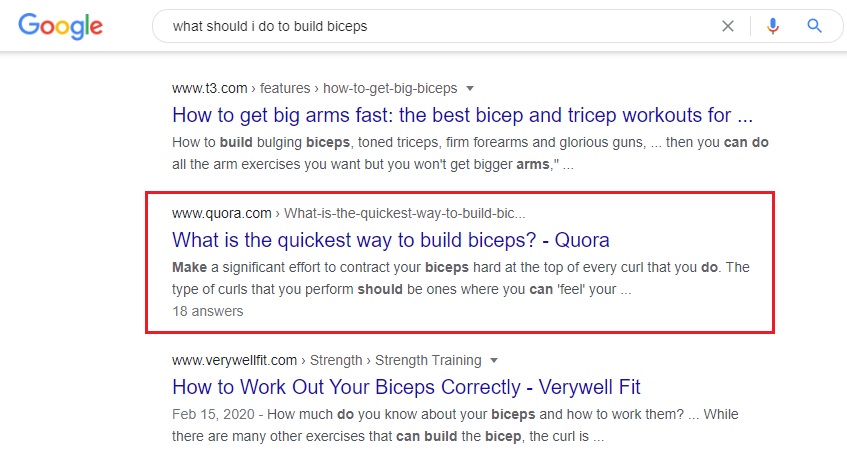

Quora is great platform to build your image as a knowledgeable personal trainer. If you look around in Quora, you’ll see more people like Geoffrey who are successfully using Quora to market their personal training business.
